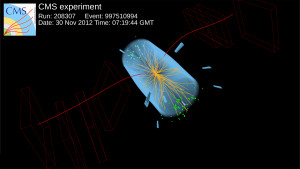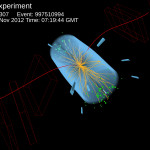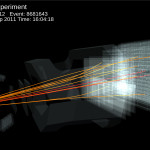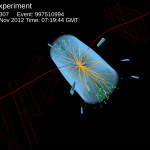Two experiments at the Large Hadron Collider at the European Organization for Nuclear Research (CERN) in Geneva, Switzerland, have combined their results and observed a previously unseen subatomic process.
As published in the journal Nature this week, a joint analysis by the CMS and LHCb collaborations has established a new and extremely rare decay of the Bs particle (a heavy composite particle consisting of a bottom antiquark and a strange quark) into two muons. Theorists had predicted that this decay would only occur about four times out of a billion, and that is roughly what the two experiments observed.
“It’s amazing that this theoretical prediction is so accurate and even more amazing that we can actually observe it at all,” said Syracuse University Professor Sheldon Stone, a member of the LHCb collaboration. “This is a great triumph for the LHC and both experiments.”
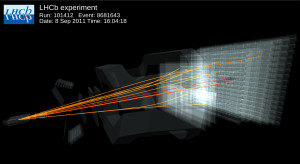
Event displays from the CMS (above) and LHCb (below) experiments on the Large Hadron Collider show examples of collisions that produced candidates for the rare decay of the Bs particle, predicted and observed to occur only about four times out of a billion. Images: CMS/LHCb collaborations
LHCb and CMS both study the properties of particles to search for cracks in the Standard Model, our best description so far of the behavior of all directly observable matter in the universe. The Standard Model is known to be incomplete since it does not address issues such as the presence of dark matter or the abundance of matter over antimatter in our universe. Any deviations from this model could be evidence of new physics at play, such as new particles or forces that could provide answers to these mysteries.
“Many theories that propose to extend the Standard Model also predict an increase in this Bs decay rate,” said Fermilab’s Joel Butler of the CMS experiment. “This new result allows us to discount or severely limit the parameters of most of these theories. Any viable theory must predict a change small enough to be accommodated by the remaining uncertainty.”
Researchers at the LHC are particularly interested in particles containing bottom quarks because they are easy to detect, abundantly produced and have a relatively long lifespan, according to Stone.
“We also know that Bs mesons oscillate between their matter and their antimatter counterparts, a process first discovered at Fermilab in 2006,” Stone said. “Studying the properties of B mesons will help us understand the imbalance of matter and antimatter in the universe.”
That imbalance is a mystery scientists are working to unravel. The big bang that created the universe should have resulted in equal amounts of matter and antimatter, annihilating each other on contact. But matter prevails, and scientists have not yet discovered the mechanism that made that possible.
“The LHC will soon begin a new run at higher energy and intensity,” Butler said. “The precision with which this decay is measured will improve, further limiting the viable Standard Model extensions. And of course, we always hope to see the new physics directly in the form of new particles or forces.”
This discovery grew from analysis of data taken in 2011 and 2012 by both experiments. Scientists also saw some evidence for this same process for the Bd particle, a similar particle consisting of a bottom antiquark and a down quark. However, this process is much more rare and predicted to occur only once out of every 10 billion decays. More data will be needed to conclusively establish its decay to two muons.
The U.S. Department of Energy Office of Science provides funding for the U.S. contributions to the CMS experiment. The National Science Foundation provides funding for the U.S. contributions to the CMS and LHCb experiments. Together, the CMS and LHCb collaborations include more than 4,500 scientists from more than 250 institutions in 44 countries.
Fermilab is America’s premier national laboratory for particle physics and accelerator research. A U.S. Department of Energy Office of Science laboratory, Fermilab is located near Chicago, Illinois, and operated under contract by the Fermi Research Alliance LLC. Visit Fermilab’s website at www.fnal.gov and follow us on Twitter at @Fermilab.
The DOE Office of Science is the single largest supporter of basic research in the physical sciences in the United States and is working to address some of the most pressing challenges of our time. For more information, please visit science.energy.gov.
The National Science Foundation (NSF) is an independent federal agency that supports fundamental research and education across all fields of science and engineering. In fiscal year (FY) 2015, its budget is $7.3 billion. NSF funds reach all 50 states through grants to nearly 2,000 colleges, universities and other institutions. Each year, NSF receives about 48,000 competitive proposals for funding, and makes about 11,000 new funding awards. NSF also awards about $626 million in professional and service contracts yearly.
CERN, the European Organization for Nuclear Research, is the world’s leading laboratory for particle physics. It has its headquarters in Geneva. At present, its Member States are Austria, Belgium, Bulgaria, the Czech Republic, Denmark, Finland, France, Germany, Greece, Hungary, Israel, Italy, the Netherlands, Norway, Poland, Portugal, Slovakia, Spain, Sweden, Switzerland and the United Kingdom. Romania is a Candidate for Accession. Serbia is an Associate Member in the pre-stage to Membership. India, Japan, the Russian Federation, the United States of America, Turkey, the European Union, JINR and UNESCO have Observer Status.




